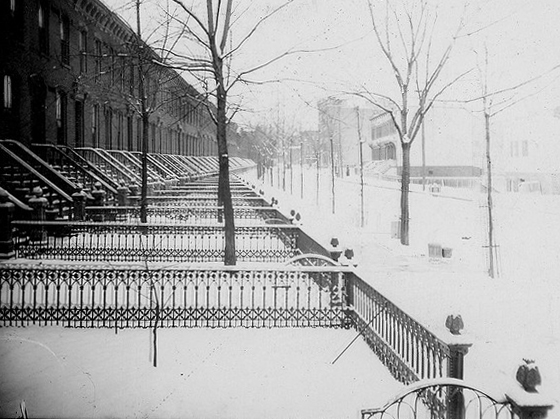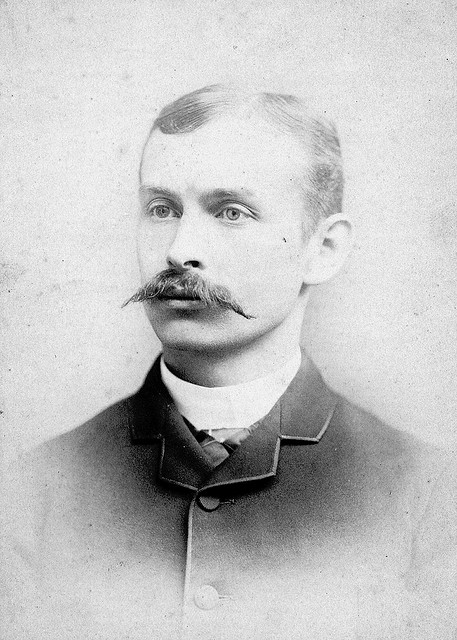Fort Lee has been in the news lately. Seems traffic access to the George Washington Bridge from Fort Lee was sphinctered for political purposes, at the spot marked “B” on this map here:

(This was later the place where “bridgegate” took place.) The spot marked “A” is the site of my first home: 2063 Hoyt Avenue. Here’s how it looked in 1920:
My grandfather, George W. Searls, built it in 1900 or so. He and grandma, Ethel F. (née Englert) Searls, raised thee children there: Ethel M. Searls, born in 1905, Allen H. Searls (my father), born in 1908, and Grace (née Searls) Apgar, born in 1912. Grandpa died in 1935, but Grandma and Aunt Ethel lived here until 1955, when I was eight years old.
It was in a fine old neighborhood of similar mansard-roofed homes, most of which were built before the George Washington Bridge showed up and became the town’s landmark feature. Pop, who grew up climbing the Palisades and had no fear of heights, helped build the bridge, mostly by rigging cables.
Not long after finding a place to stay in New York in Fall of 2012, my wife and I took a walk across the bridge to visit the old neighborhood. I knew the old house was gone, the land under it paved over by Bruce Reynolds Boulevard. What I didn’t expect was finding that the entire neighborhood had been erased. See the brown area on the map above, between the highway and Main Street? That was it. Palisade Avenue, behind Hoyt, is now a house-less strip of rotting pavement flanked and veined by wild grass. The only animal life we spotted was a large groundhog that ran to an old storm drain when we approached.
Little of the Fort Lee I knew as a kid is still there. The only familiar sights on Main Street are City Hall and the old fire station. Dig this: City Hall also shows up in the background of this shot of Mom with my cousin Paul and I, when we were both a few months old, in April 1948. This street too has been obliterated: replaced by stores and parking lots, with no trace of its old self.
When I was a kid in the ’50s, my grandparents’ generation — all born in the second half of the 19th Century — was still going strong. One relative I remember well was great-aunt Eva Quackenbush, Grandpa Searls’ older sister. Here she is with Mom, and the baby me. Eva was born in 1853, and was twelve years old when President Lincoln was shot — and event she talked about. She visited often from her home in St. Louis, and died just a few days short of 100 years old, in 1953. Living long is a Searls family trait. Grandma made it to 107 and Aunt Grace to 101 (she passed just last month, fun and lucid to the end).
So to me the world before cars, electricity and other modern graces was a familiar one, because I heard so many stories about it. Grandma grew up in The Bronx, at 742 East 142nd Street, when it looked like this:
Today, according to Google’s StreetView, it looks like this:
The red A marks 732. On the left, behind that wall, is a “towed car” lot. It sits atop a mound of rubble that was once “old Lincoln Hospital”:
According to the Wikipedia article on Lincoln Hospital, “In 1895, after more than half a century of occupying various sites in Manhattan, the Board of Trustees purchased a large lot in the South Bronx—then a semi-rural area of the city—at the corner of 141st Street and Southern Boulevard.” This is a morning view, lit from the southeast, looking north across 141st Street. Grandma’s place was on the back side of the hospital. Amazing to think that this scene came and went between the two shots above it.
Grandma’s father, Henry Roman Englert, was the head of the Steel and Copper Plate Engravers Union in the city. His trade was also destroyed by industrial progress, but was an art in its time. Here he is, as a sharp young man with a waxed mustache:
Henry was a fastidious dude, meaning highly disciplinary as well as disciplined. Grandma told a story about how her father, on arriving home from work, would summon his four daughters to appear and stand in a row. (A fifth daughter, Grace, died at age 1. My aunt Grace, mentioned above, granddaughter of Henry and Kitty, lived to 101.) He would then run his white glove over some horizontal surface and wipe it on a white shoulder of a daughter’s dress, expecting no dust to leave a mark on either glove or girl. Henry was the son of German immigrants: Christian Englert and Jacobina Rung, both of Alsace, now part of France. They were brewers, and had a tavern on the east side of Manhattan on 110th Street. (Though an 1870 census page calls Christian a laborer.) Jacobina was a Third Order Carmelite nun, and was buried in its brown robes. Both were born in 1825. Christian is said to have died in 1886 while picking hops in Utica. Jacobina died in 1904.
Grandma (Ethel F. Englert) met Grandpa (George W. Searls) in 1903, when she was twenty and he was forty. She was working as a cleaning woman in the Fort Lee boarding house where Grandpa lived while he worked as a carpenter. One day she saw him laying asleep, and bent down to kiss him. He woke, reached up, pulled her down and kissed her back. Romance commenced.
Grandma was embarrassed about having done cleaning work, insisting always that she was “lace curtain Irish,” to distinguish her family (or her Mom’s side) from “shanty Irish.” When ethnic matters came up in conversation over dinner, she would often say “All for the Irish stand up,” and everybody would rise. Her mother, Catherine “Kitty” Trainor, died at 39. Henry later married an Italian woman and produced more progeny, only one of whom was ever mentioned by Grandma. That was Harry, who died at age five. The largest framed photograph in Grandma’s house was one of Harry, looking up and holding a toy.
Kitty’s dad was Thomas Trainor, who came over from Ireland in 1825 at age 15 to escape England’s harsh penal laws. (He shipped out of Letterkenny with an uncle, but the Trainors were from south of there. Trainor was anglicized from the Gaelic Tréinfhir, meaning “strong man.”) Thomas worked as an indentured servant in the carriage trade, and married Catherine McLaughlin, the daughter of his boss. Thomas then prospered in the same business, building and fixing carriages at his shop at the south end of Broadway. His two daughters were Kitty and “Aunt Mag” Meyer, whom Grandma often quoted. The line I best remember is, “You’ve got it in your hand. Now put it away.” Mag taught Grandma how to walk quietly while large numbers of other people in the house were sleeping. Grandma passed the same advice to her grandkids, including me: “Walk on the balls of your feet, toes first.” The Trainors also had a son, who ran away to fight in the Civil War. When the war ended and the boy didn’t come home, Thomas went down to Washington and found his son in a hospital there, recovering from a wound. The doctors said the boy would be home by Christmas. And, when Christmas came, the boy indeed arrived, in a coffin. Or so the story went.
An interesting fact about Fort Lee: it was the original Hollywood. The Searls family, like most of the town, was involved. Grandpa was D.W. Griffith’s head carpenter, building film sets such as this one here. Here he is (bottom right) with his crew. Here’s a link for the Fort Lee Film Commission, featuring samples of the silent movies made there. Among the extras are family members. Lillian Gish and Lon Chaney both boarded upstairs at 2063 Hoyt. So did the dad of the late Elliot Richardson, a cabinet member in the Nixon and Ford administrations.
Time flies, and so do people, places and memories. My parents’ generation is now gone, and family members of my own generation are starting to move on. I can count ten places I used to live that are now gone as well, including my high school. Kevin Kelly told me a couple years ago that none of us, even the famous, will be remembered in a thousand years. I’m sure he’s right.
But I still feel the urge to pour as much as I can of what I know into the public domain, which is what you’re witnessing now, if you’re still with me at the bottom of a long post. I believe it helps to see what was, as well as what is.
For example, this view up Hoyt Avenue from the site of the old Searls place, in 2012, is now filled with a high-rise that is almost complete. The little bridge-less town where my grandparents met and my father and his sisters grew up is now a henge of high-rises. Fort Lee itself is also known as Fort Lee Koreatown. In this constantly shifting urban context, the current scandal seems a drop in the bucket of time.
Save





Leave a Reply